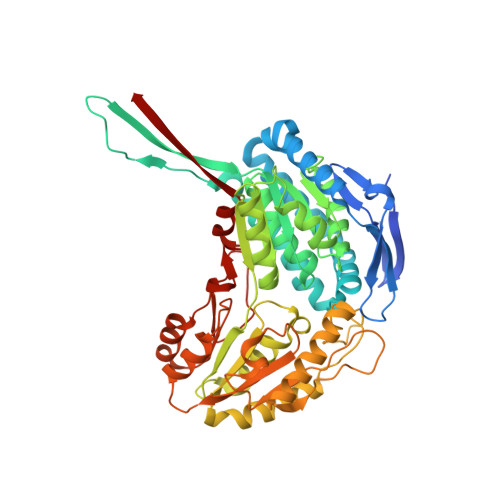The mechanism of discrimination between oxidized and reduced coenzyme in the aldehyde dehydrogenase domain of Aldh1l1.
Tsybovsky, Y., Malakhau, Y., Strickland, K.C., Krupenko, S.A.(2013) Chem Biol Interact 202: 62-69
- PubMed: 23295222
- DOI: https://doi.org/10.1016/j.cbi.2012.12.015
- Primary Citation of Related Structures:
4GNZ, 4GO0, 4GO2 - PubMed Abstract:
Aldh1l1, also known as 10-formyltetrahydrofolate dehydrogenase (FDH), contains the carboxy-terminal domain (Ct-FDH), which is a structural and functional homolog of aldehyde dehydrogenases (ALDHs). This domain is capable of catalyzing the NADP(+)-dependent oxidation of short chain aldehydes to their corresponding acids, and similar to most ALDHs it has two conserved catalytic residues, Cys707 and Glu673. Previously, we demonstrated that in the Ct-FDH mechanism these residues define the conformation of the bound coenzyme and the affinity of its interaction with the protein. Specifically, the replacement of Cys707 with an alanine resulted in the enzyme lacking the ability to differentiate between the oxidized and reduced coenzyme. We suggested that this was due to the loss of a covalent bond between the cysteine and the C4N atom of nicotinamide ring of NADP(+) formed during Ct-FDH catalysis. To obtain further insight into the functional significance of the covalent bond between Cys707 and the coenzyme, and the overall role of the two catalytic residues in the coenzyme binding and positioning, we have now solved crystal structures of Ct-FDH in the complex with thio-NADP(+) and the complexes of the C707S mutant with NADP(+) and NADPH. This study has allowed us to trap the coenzyme in the contracted conformation, which provided a snapshot of the conformational processing of the coenzyme during the transition from oxidized to reduced form. Overall, the results of this study further support the previously proposed mechanism by which Cys707 helps to differentiate between the oxidized and reduced coenzyme during ALDH catalysis.
Organizational Affiliation:
Department of Biochemistry and Molecular Biology, Medical University of South Carolina, Charleston, SC 29425, USA.



















